Most people will never see a flamingo outside of a zoo, and yet these curious-looking birds are easily one of the most recognizable animals on the planet. Their graceful swan-like necks, vibrant colors, goofy behaviors, and stoic posture have made them iconic animals for people all over the world. There is even an International Flamingo Day! While many adore these peculiar pink birds, how much do we really know about them? Let’s take a deeper look at 10 incredible flamingo facts!
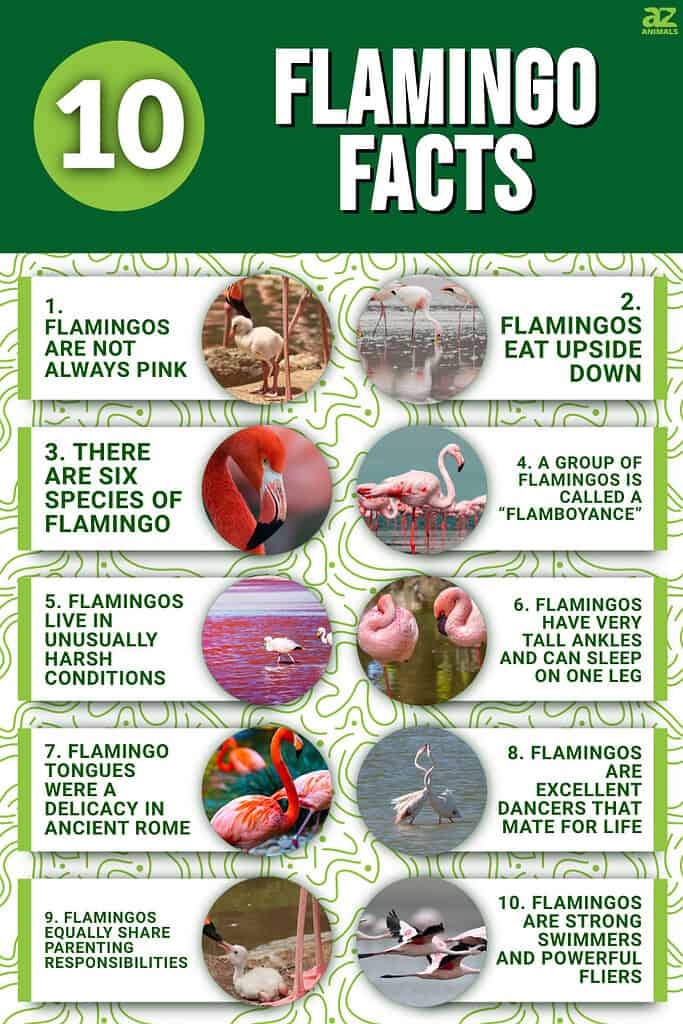
1. Flamingos Are Not Always Pink

Baby flamingos are born with white or gray fluffy plumage that helps to keep their small bodies warm.
©mumin-uppi/Shutterstock.com
Since 1957, millions of plastic pink flamingos have decorated lawns across America. However, did you know that flamingos are not always pink? Baby flamingos are born with gray or white fluffy plumage, and do not develop pink coloring for at least two or three years. In fact, even adult flamingos can lose their iconic colors!
One of the incredible facts about flamingos is that the pink coloring of their feathers comes from the food they eat. Flamingos eat things like small crustaceans, shrimp, and algae from saltwater habitats. These contain carotene, a pigment that affects the red coloring in many plants and animals. For example, carotene is what makes tomatoes red and carrots orange.
Over time these carotenoids begin to add a red, pink, or orangish hue to a flamingo’s feathers. What flamingos eat and how much they eat affects the intensity of color in their feathers. That is also why some flamingos are brighter pink, while others have paler tones. Caribbean or American Flamingos, for example, have brilliant coral-pink feathers, while Greater Flamingos have pale pink colors.
2. Flamingos Eat Upside Down
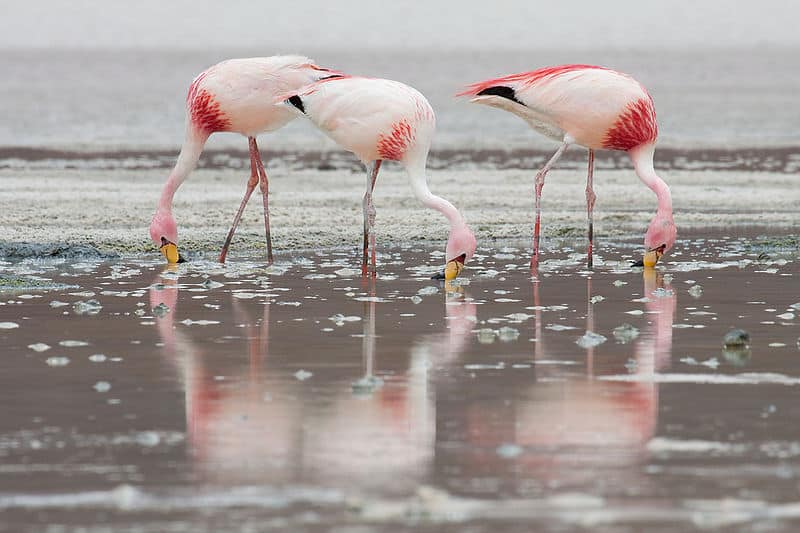
Flamingos eat for several hours every day.
A flamingo’s neck has 19 bones, which gives it a lot of flexibility. This comes in handy for flamingos, since the food they eat is at the bottom of ponds and lakes. A flamingo will flip its head upside down into the water to scoop up algae, small crustaceans, mollusks, insects, and small fish. Small, brush-like plates in the flamingo’s bill (called “lamellae”) filter out any extra water and sediment, leaving only its tasty food behind.
3. There Are Six Species of Flamingo
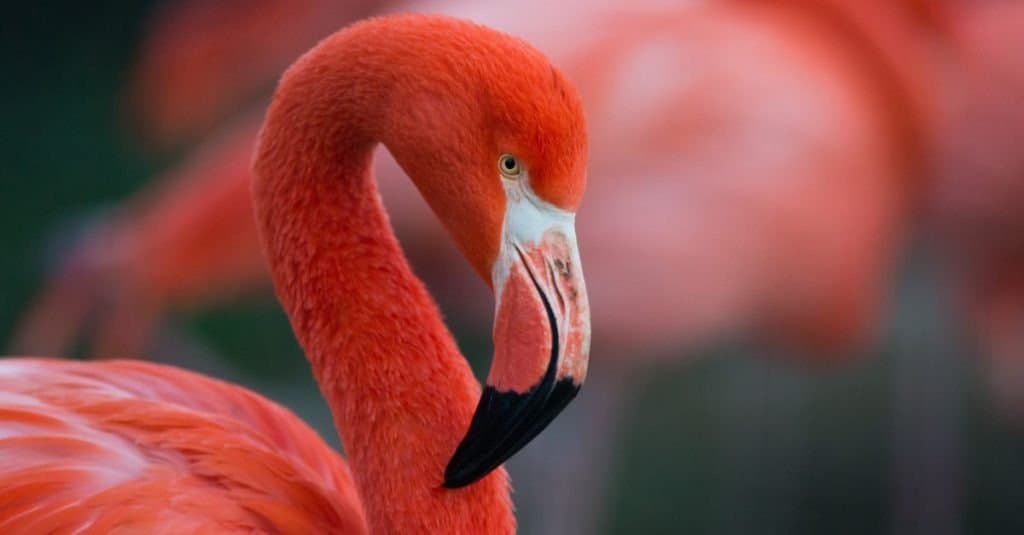
The Caribbean (or American) Flamingo has the brightest coloring of all flamingo species.
©Mrinal Pal/Shutterstock.com
There are six flamingo species that live all over the world, from Europe to the Middle East, Asia, Africa, South America, the Caribbean, and even a few in Florida. The greater flamingo is the largest flamingo species and can grow up to five feet tall! The lesser flamingo, on the other hand, is the smallest, measuring only three feet tall at most. The rarest species is the Andean flamingo, found in the Andean mountains of South America. Andean flamingos, along with James’ flamingo, the Chilean flamingo, and the lesser flamingo, are vulnerable to or threatened with extinction.
4. A Group of Flamingos is Called a “Flamboyance”

Flamingos are social animals and prefer living in a large group called a “flamboyance.”
©iStock.com/YULIIA LAKEIENKO
Flamingos are gregarious social birds that like to stick together in large numbers of at least 12 birds. However, some groups may have thousands of flamingos! A group of flamingos is called a flamboyance, although sometimes it is also referred to as a regiment, a flock, a stand, or a colony. However, “flamboyance” seems most fitting for a large group of these flamboyant-looking birds.
5. Flamingos Live in Unusually Harsh Conditions
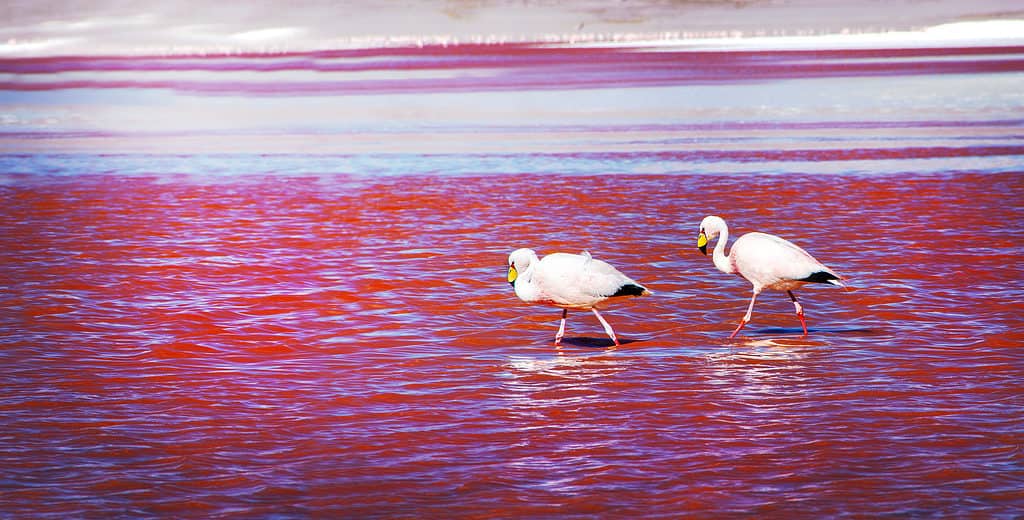
Flamingos can handle water up to 150°F, and handle water twice as salty as the ocean!
©iStock.com/Zenobillis
Flamingos live in coastal lagoons, lakes, marshlands, mudflats, tidal flats, mangrove swamps, and sandy islands. However, these goofy birds are not too picky about the water conditions. For example, they can handle water as hot as 150°F, as well as nighttime temperatures that reach -22°F.
In addition, flamingos can live just fine in both freshwater and saltwater. Sometimes the water can be twice as salty as the ocean! However, flamingos have a gland that filters the salt out of the water, and they often rinse off in freshwater afterward.
Flamingos can even survive in corrosive “soda” lakes. Soda lakes are extremely alkaline and have large amounts of carbonate salts. Only certain types of bacteria and fish can live in these areas because the water’s chemical composition will burn most animals. However, somehow flamingos make it work. Many flamingos enjoy these habitats because they keep potential predators away, allowing them to eat in peace.
6. Flamingos Have Very Tall Ankles and Can Sleep on One Leg
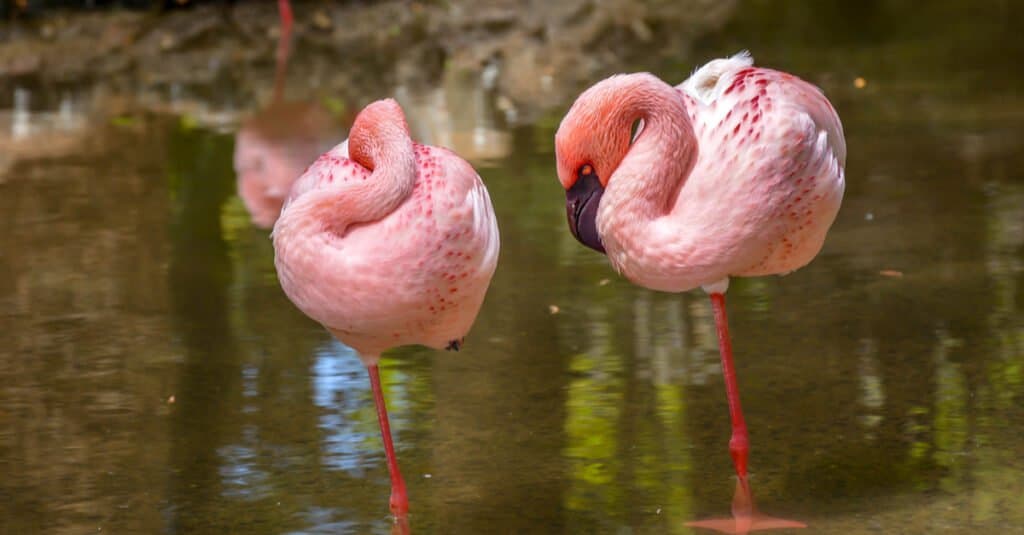
Flamingos never fully sleep. Half of its brain is always awake and alert.
©IndreJeg/Shutterstock.com
Scientists are not exactly sure why, but flamingos often stand on only one foot, keeping the other foot tucked under their bodies. It looks like their knee is bent backwards at a strange angle. However, the joint that is bending is not a knee at all—it is actually the flamingo’s ankle! Their knees are much higher up on their legs, close to their bodies. They are hard to see because they are often covered by their feathers.
Although we don’t know why flamingos stand on just one leg, there are a few theories. It is possible that flamingos do this to conserve body heat, particularly when they are in cold water. A flamingo’s feathery plumage helps to keep its body warm, and it loses body heat through its legs. Tucking one leg up might help a flamingo regulate its body temperature.
Flamingos also utilize more muscle power when they stand on two legs, so standing on one leg might be less tiring. Whatever the reason, flamingos often stand on one foot and never seem to get tired. In fact, flamingos can sleep on just one leg without any trouble at all!
7. Flamingo Tongues Were a Delicacy in Ancient Rome
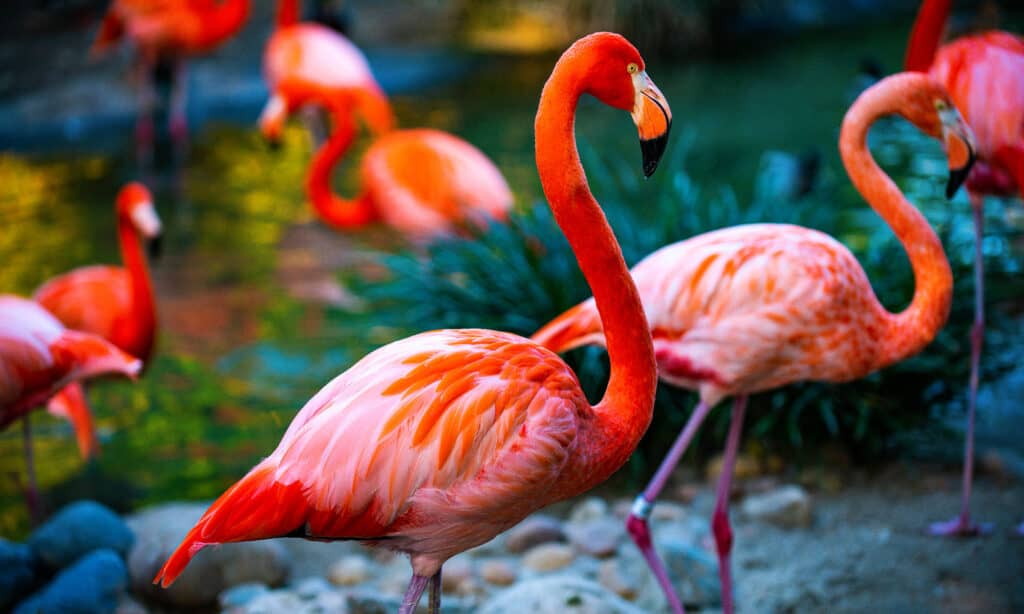
It’s disturbing to know that ancient Romans consumed these beautiful birds, particularly preferring their tongues as a delicacy.
©Volodymyr TVERDOKHLIB/Shutterstock.com
This fact is more than a bit strange today, but ancient Romans actually ate flamingo tongues! Although the entire bird was considered a middle-class meal, a flamingo’s tongue was a delicacy. Only high-ranking or wealthy Romans could afford such a luxury. In some cases, they also cooked the meat. Serving “Roast Fenicopterus” or “scarlet-wing” at a dinner party was an elite status symbol. Today, fortunately, flamingos are a protected species and it is illegal to eat or kill these extraordinary birds.
8. Flamingos are Excellent Dancers That Mate for Life
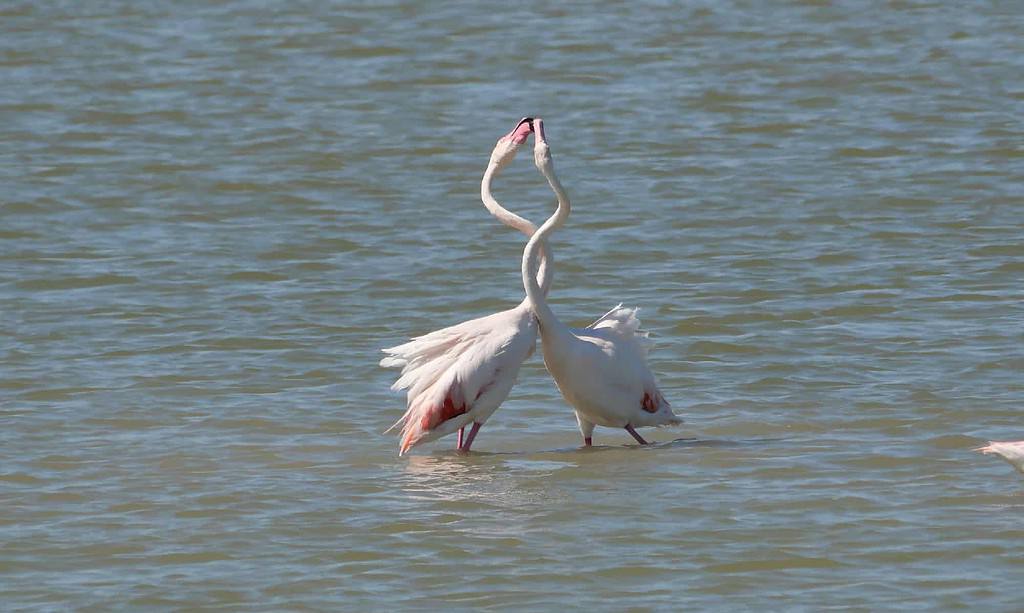
A pair of flamingoes with their necks twined together during their mating dance.
©FilippoPH/Shutterstock.com
During mating season, male flamingos perform complicated dance moves in order to secure a partner. So far, scientists have been able to map out at least 136 combinations of dance moves in greater flamingos. For example, “head flagging” is a common starter move. Male flamingos gather in a synchronized march while flipping their heads from side to side. Unlike many other bird species, female flamingos also join in once the dance gets going. If a female is impressed with a male’s dance moves, she will become his lifelong mate.
9. Flamingos Equally Share Parenting Responsibilities

Flamingo chicks do not develop their flying feathers until around 11 weeks of age.
©Deb Kletch/Shutterstock.com
After mating a male and female flamingo help each other to build a nest out of mud for a single egg. Even if something happens to the egg, the female flamingo will not lay another one until the following year. Because of this, it takes flamingo populations several years to rebound from predators and natural disasters.
Both the male and female take turns incubating the egg. Once the baby flamingo hatches, the parents continue to equally take turns caring for it. Baby flamingos are born with white or gray fluffy plumage that helps to keep their small bodies warm. For the first few months, they only drink “crop milk” made by their parents. Male and female flamingos produce crop milk in their digestive tracts and then regurgitate it for their young baby. Crop milk might sound awful, but it is extremely high in fats and proteins, giving baby flamingos everything they need to grow and thrive.
10. Flamingos Are Strong Swimmers and Powerful Fliers
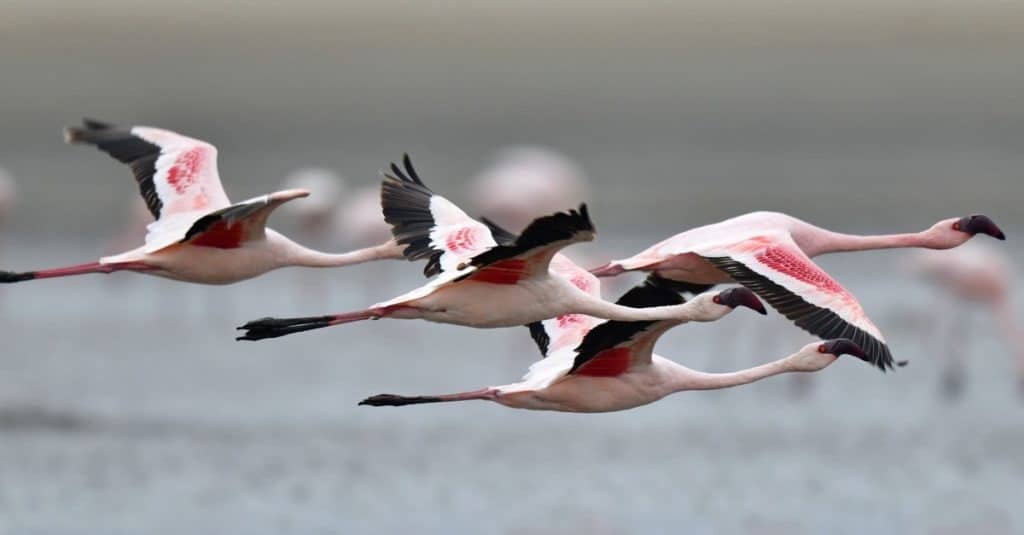
When flamingos migrate, they typically do so at night, preferring to fly with a cloudless sky and favorable tailwinds.
©Sergey Uryadnikov/Shutterstock.com
A flamingo’s long, lanky body can look clumsy when it moves around. However, flamingos are actually strong swimmers and very formidable fliers. Although most birds tuck their feet up when they fly, flamingos stretch their long legs out beneath them. This helps them with balance and makes them more aerodynamic. In fact, flamingos can fly up to 35 miles an hour! Flamingos regularly fly between their nesting grounds and feeding areas. Many flamingos also migrate when the climate or food availability changes. They typically fly at night to avoid predators and can travel over 350 miles in a single night!
The photo featured at the top of this post is © iStock.com/YULIIA LAKEIENKO
Thank you for reading! Have some feedback for us? Contact the AZ Animals editorial team.







